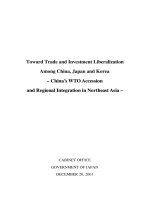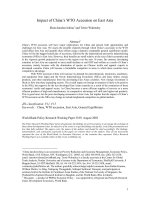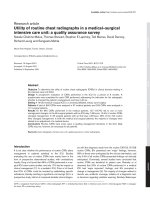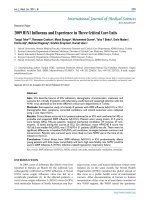unit china
Bạn đang xem bản rút gọn của tài liệu. Xem và tải ngay bản đầy đủ của tài liệu tại đây (1.1 MB, 28 trang )
China
Facts
Almost as big as Europe
It is the most populated country in the world
(1,330,141,000 – 2010)
1/5 of total population of the world (!)
Rate of Natural Increase =
Natural Increase / Population x 100
0.6% annual growth rate
Population density is very uneven
The majority of the population (95%) live in the eastern part
In the western part: large areas are unpopulated
Reflects the different
physical conditions
physical
conditions
Western part: mountains,
plateau, deserts
– climate and soil are unfavorable
for agriculture
Eastern part: has been
inhabited for thousands of years
– fertile soils, favorable climate for
agriculture
(wet continental, humid
subtropical)
Problems with providing food…
Could only be solved by a radical policy
which concerns the growth of population
For this traditional Chinese society had to be changed
Legal age for marriage is higher (22 for males, 20 for females)
Planning births
One child policy
Natural increase is lower than in other developing countries in Asia (!)
End goal – zero population growth
Difficult to achieve because of the large population base
Agriculture – arable land
1/10 of the area of China is arable land
The main area: eastern part, 2 harvests are possible – very important since
the extenction is limited
IRRIGATION significant
Requires a lot of water
Most important
crop: RICE
FERTILISATION
DEVELOPMENT, helped to increase
PRODUCTIVITY
crops
Leading crop: RICE
Wheat: mainly in the northern parts (precipitation is not sufficient for rice),
southern parts in the dry season
Soybean
Peanut
Cotton
TEA
Livestock rearing is less important
Food crops are grown on the arable lands
Pig
Poultry
Cattle – raised for its power
FISHING: has an important role in providing food for the population
Fish Market
Industry
Coal
fields
Large localities of
Iron ore
•
Large localities of
hydrocarbons
close to
energy
Mainly generated is thermal power stations based on coal
Hydroelectric power
The textile industry
Before the Second World War the only significant branch
Cheap labour force
Lots of factories
Imported raw material
Products were exported
factories were built in harbours
(Sanghai, Tianjin, Guangzhou)
The textile industry – new factories
In the central parts
Use local raw materials
Products sold in the country
Heavy industry
The main region: Manchurian Plain
Shenyang
Anshan
North China: Beijing
Tangshan
Baotou
Along the Yangtze river in Chongqing, Wuhan
Industry has become versatile
Distribution of industry is more even
Roads, railroads have been built
Provinces try to be self-sufficient – difficulties in transport, enormous
distances
Special economic areas in the southern coast of the country
Foreign capital is welcomed
Goods for export
Government helps investments: abolition of import duties on raw materials
and machines
The MAIN SCENES of MODERNISATION (Southern coast)
Foreign trade has also been rising significantly
More and more industrial products among exported goods
Macao
former colony
part of china (1999)
Hong Kong
Has an important role in the rapid development
The relic of colonalism – long-time British colony
Provided cheap but qualified labour force









